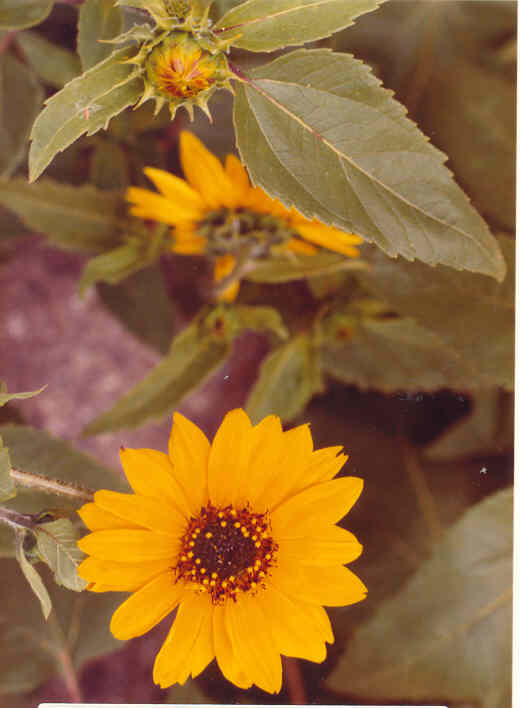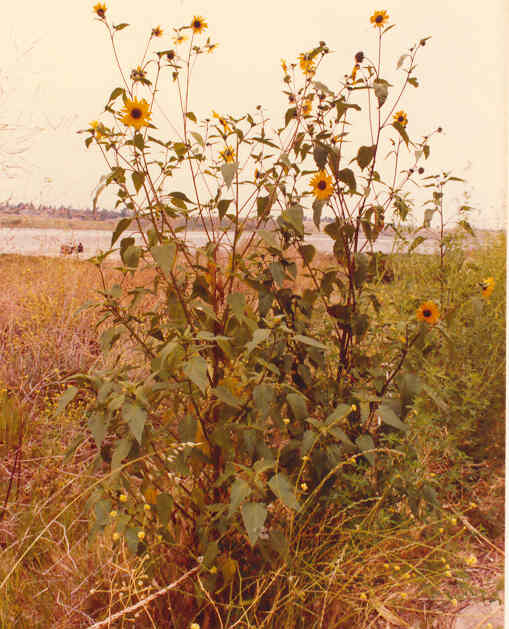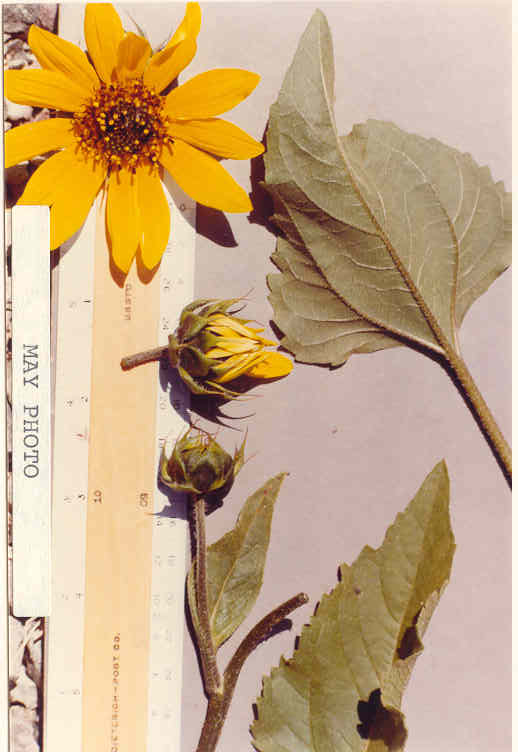
 |
Helianthus annuus L.= Helianthus annuus ssp. lenticularisAsteraceae (Sunflower Family)NativeCommon SunflowerWestern SunflowerAnnual Sunflower |
Plant Characteristics: Annual,
stem usually stout, 3-20 or more dm. high, often openly branched, very hispid;
herbage rough-hairy; lvs. petioled, the blade 6-15 cm. long, narrowly to broadly
ovate, truncate or cordate at base, mostly serrate, the uppermost often entire;
heads large, the low-convex often reddish disk 2-3.5 cm. wide; phyllaries
narrowly to broadly ovate, abruptly and slenderly acuminate, densely scabrous
and usually at least medianly hirsute-hispid; dorsally, strongly hispid-ciliate;
paleae often 3 toothed, not conspicuously hairy; fr. 3-15 mm.
Habitat:
Roadsides and waste places, frequent at lower elevs., occasional up to
5000 ft.; many plant communities; throughout our area except for the Mojave
Desert; to Can., Mex. Feb-Oct.
Name: Greek, helios, sun, and anthos,
fl. (Munz, Flora So. Calif. 183). Latin,
annuus, annual.
(Jaeger 19).
General: Occasional in
the study area. Photographed along
Back Bay Dr. northerly of Big Canyon. (my
comments). The
nutritious seeds were tasty to the Native American populations.
A useful fibre was taken from the coarse stalks and a good dye was made
from the flowers. The name was
given to the flower because it was supposed to turn always to the sun.
Scientists explained this with the hypothesis that the stem grows more
quickly on the shaded side than on the other.
It worried some of the early herbalists when they encountered a variety
with several blooms all facing in different directions.
(Dale 66). The
annual sunflower does follow the sun to a considerable degree.
But not every flower on the plant is so placed that it is able to do so.
(John Johnson). Used by the Pimas as string for candles.
Crushed seeds were boiled for their oil.
(Clarke 219). The
seeds were used to make a purple and black dye; the flowers a yellow dye.
(Heizer and Elsasser 136).
The plant was much used by Indians who did not cultivate maze, the seeds
were used for flour and thickening soup. The
seeds are first parched and then pounded between two stones, until they are
reduced to a fine meal. (Coon 136).
Grinding the seeds and shells together produces an edible paste due to
the oil content of the seeds. (lecture
by Charlotte Clarke, author of Useful and
Edible Plants of California, April 1987).
One of the sunflowers, H. annuus,
is still known by reservation Indians in the Dakotas as a remedy for pulmonary
ailments. They boil sunflower heads
and drink the medicine. (Fielder
149). Helianthus
species have been known to cause hay fever and asthma.
(Fuller 379).
H. annuus has been found to
accumulate free nitrates in quantities capable of causing death or distress to
cattle. (Fuller 384).
Its seeds are used by the Indians in the preparation of hair-oil.
This wild sunflower of the plains is believed to be the original parent
of the large sunflower of our gardens. (Parsons
190). Parson's
book was published in 1909. (my
comment). The
Cahuilla, Indians of the
Text Ref: Abrams, Vol.
IV 113; Hickman Ed. 278; Munz, Calif.
Flora 1088; Munz, Flora So. Calif.;
Roberts 11. 183.
Photo Ref: June 5 83 # 3,4; May 2 84 # 7A.
Identity: by R.
De Ruff, confirmed by F. Roberts.
First Found: June 1983
Computer Ref: Plant Data 181.
Have plant specimen.
Last edit
5/8/05.
 |
 |
June Photo May Photo